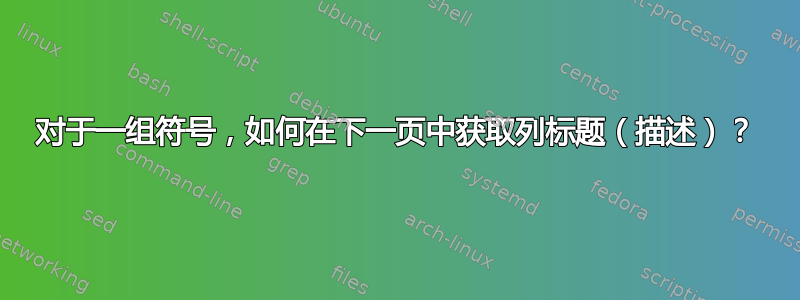
这个问题参考了如何实现命名条目,如:符号、描述、尺寸和单位等?
我可以为不同的类别实现不同的样式。排序也按照图中所示的方式进行。

然而,实际情况是,如果某个类别从一页开始并延续到下一页,则标题不会出现在下一页中。如果内容不适合一页,我希望能够在下一页中显示标题。请提出一种能够在新页面中显示标题的方法。
答案1
您可以使用以下方式轻松实现此目的glossaries代替nomencl。
- 为不同类型的符号创建单独的词汇表。
- 为您需要的任何附加字段添加键 (
dimension,unit,definition)。 - 根据需要创建词汇表样式。我采用了预定义样式
long3col-booktabs并long4col-booktabs对其进行了修改。 - 添加词汇表条目。我本地重新定义了
\glsdefaulttype将许多条目放入所需词汇表中,而无需type为每个条目提供密钥。您也可以从不同的文件加载它们,或者创建自定义宏以获得同样的便利性。 - 将所有定义的条目添加到词汇表中(这样您不必在文档中使用它们)。
提醒一下: 的完整编译周期glossaries是pdflatex、makeglossaries、pdflatex、pdflatex(或等效周期)。(这是手册中的“选项 2”。)
\documentclass{article}
\usepackage[nonumberlist]{glossaries}
\usepackage{glossary-longbooktabs}
\usepackage{booktabs}
\usepackage{siunitx}
\newglossary*{nodimennum}{Dimensionless Numbers}
\newglossary*{greeksym}{Greek Symbols}
\glsaddkey{dimension}
{--}
{\glsentrydimension}
{\Glsentrydimension}
{\glsdimension}
{\Glsdimension}
{\GLSdimension}
\glsaddkey{unit}
{--}
{\glsentryunit}
{\Glsentryunit}
{\glsunit}
{\Glsunit}
{\GLSunit}
\glsaddkey{definition}
{--}
{\glsentrydefinition}
{\Glsentrydefinition}
{\glsdefinition}
{\Glsdefinition}
{\GLSdefinition}
\glssetnoexpandfield{dimension}
\glssetnoexpandfield{unit}
\newcommand*\dimensionname{Dimension}
\newcommand*\unitname{Unit}
\newcommand*\definitionname{Definition}
\newglossarystyle{nodimennum}{%
\glspatchLToutput
\renewenvironment{theglossary}%
{\begin{longtable}{l p{.35\linewidth} p{.35\linewidth}}}%
{\end{longtable}}%
\renewcommand*{\glossaryheader}{%
\toprule
\bfseries \symbolname &
\bfseries \descriptionname &
\bfseries \definitionname
\tabularnewline\midrule\endhead
\bottomrule\endfoot}%
\renewcommand*{\glsgroupheading}[1]{}%
\renewcommand{\glossentry}[2]{%
\glsentryitem{##1}\glstarget{##1}{\glossentrysymbol{##1}} &
\glossentrydesc{##1} &
\glsentrydefinition{##1} \tabularnewline
}%
\ifglsnogroupskip
\renewcommand*{\glsgroupskip}{}%
\else
\renewcommand*{\glsgroupskip}{\glspenaltygroupskip}%
\fi
}
\newglossarystyle{physsym}{%
\glspatchLToutput
\renewenvironment{theglossary}%
{\begin{longtable}{l l l l}}%
{\end{longtable}}%
\renewcommand*{\glossaryheader}{%
\toprule \bfseries \symbolname &
\bfseries \descriptionname &
\bfseries \dimensionname &
\bfseries \unitname
\tabularnewline\midrule\endhead
\bottomrule\endfoot}%
\renewcommand*{\glsgroupheading}[1]{}%
\renewcommand{\glossentry}[2]{%
\glsentryitem{##1}\glstarget{##1}{\glossentrysymbol{##1}} &
\glossentrydesc{##1} &
\glsentrydimension{##1} &
\glsentryunit{##1} \tabularnewline
}%
\ifglsnogroupskip
\renewcommand*{\glsgroupskip}{}%
\else
\renewcommand*{\glsgroupskip}{\glspenaltygroupskip}%
\fi
}
\begingroup\renewcommand*\glsdefaulttype{greeksym}
\newglossaryentry{eps0}{
name={eps0},
symbol={\(\varepsilon_0\)},
description={vacuum permittivity},
dimension={\(\mathrm F / \mathrm L\)},
unit={\si{\farad\per\meter}},
}
\endgroup
\begingroup\renewcommand*\glsdefaulttype{nodimennum}
\newglossaryentry{zero}{
name={0},
symbol={\(0\)},
description={zero},
definition={the smallest natural number},
}
\newglossaryentry{one}{
name={1},
symbol={\(1\)},
description={one},
definition={\(0 + 1\)},
}
\newglossaryentry{two}{
name={1},
symbol={\(2\)},
description={two},
definition={\(1 + 1\)},
}
\newglossaryentry{three}{
name={3},
symbol={\(3\)},
description={three},
definition={\(2 + 1\)},
}
\newglossaryentry{four}{
name={4},
symbol={\(4\)},
description={four},
definition={\(3 + 1\)},
}
\newglossaryentry{five}{
name={5},
symbol={\(5\)},
description={five},
definition={\(4 + 1\)},
}
\newglossaryentry{six}{
name={6},
symbol={\(6\)},
description={six},
definition={\(5 + 1\)},
}
\newglossaryentry{seven}{
name={7},
symbol={\(7\)},
description={seven},
definition={\(6 + 1\)},
}
\newglossaryentry{eight}{
name={8},
symbol={\(8\)},
description={eight},
definition={\(7 + 1\)},
}
\newglossaryentry{nine}{
name={9},
symbol={\(9\)},
description={nine},
definition={\(8 + 1\)},
}
\endgroup
\makeglossaries
\glsaddall
\begin{document}
Hello World!
\vskip .6\textheight
\printglossary[type=greeksym, style=physsym]
\printglossary[type=nodimennum, style=nodimennum]
\end{document}
答案2
这是我的答案。感谢@schtandard。我稍微修改了他的代码,并能够得到更接近我需要的东西。
\documentclass[12pt,a4paper]{article}
\usepackage[inner=1in,outer=1in,tmargin=1in,bmargin=1in]{geometry}
\usepackage{tabu}
\usepackage[nonumberlist, automake]{glossaries}
\usepackage{glossary-longbooktabs}
\usepackage{booktabs}
\usepackage{siunitx}
\newglossary*{nodimennum}{Dimensionless Numbers}
\newglossary*{greeksym}{Greek Symbols}
\glsaddkey{dimension}
{--}
{\glsentrydimension}
{\Glsentrydimension}
{\glsdimension}
{\Glsdimension}
{\GLSdimension}
\glsaddkey{unit}
{--}
{\glsentryunit}
{\Glsentryunit}
{\glsunit}
{\Glsunit}
{\GLSunit}
\glsaddkey{definition}
{--}
{\glsentrydefinition}
{\Glsentrydefinition}
{\glsdefinition}
{\Glsdefinition}
{\GLSdefinition}
\glssetnoexpandfield{dimension}
\glssetnoexpandfield{unit}
\newcommand*\dimensionname{Dimension}
\newcommand*\unitname{Unit}
\newcommand*\definitionname{Definition}
\newglossarystyle{nodimennum}{%
\glspatchLToutput
\renewenvironment{theglossary}%
%{\begin{center}\begin{longtable}{@{\extracolsep{\fill}}p{.2\linewidth}p{.35\linewidth}p{.35\linewidth}}}%
{\begin{longtabu}{lXX}}%
{\end{longtabu}}%
%{\end{longtable}\end{center}}%
\renewcommand*{\glossaryheader}{%
\toprule
\bfseries \symbolname &
\bfseries \descriptionname &
\bfseries \definitionname
\tabularnewline\midrule\endhead
\bottomrule\endfoot}%
\renewcommand*{\glsgroupheading}[1]{}%
\renewcommand{\glossentry}[2]{%
\glsentryitem{##1}\glstarget{##1}{\glossentrysymbol{##1}} &
\glossentrydesc{##1} &
\glsentrydefinition{##1} \tabularnewline
}%
\ifglsnogroupskip
\renewcommand*{\glsgroupskip}{}%
\else
\renewcommand*{\glsgroupskip}{\glspenaltygroupskip}%
\fi
}
\newglossarystyle{physsym}{%
\glspatchLToutput
\renewenvironment{theglossary}%
%{\begin{center}\begin{longtable}{@{\extracolsep{\fill}} l l l l}}%
{\begin{longtabu}{l X X X}}%
{\end{longtabu}}%
%{\end{longtable}\end{center}}%
\renewcommand*{\glossaryheader}{%
\toprule \bfseries \symbolname &
\bfseries \descriptionname &
\bfseries \dimensionname &
\bfseries \unitname
\tabularnewline\midrule\endhead
\bottomrule\endfoot}%
\renewcommand*{\glsgroupheading}[1]{}%
\renewcommand{\glossentry}[2]{%
\glsentryitem{##1}\glstarget{##1}{\glossentrysymbol{##1}} &
\glossentrydesc{##1} &
\glsentrydimension{##1} &
\glsentryunit{##1} \tabularnewline
}%
\ifglsnogroupskip
\renewcommand*{\glsgroupskip}{}%
\else
\renewcommand*{\glsgroupskip}{\glspenaltygroupskip}%
\fi
}
\makeglossaries
\begingroup\renewcommand*\glsdefaulttype{greeksym}
\newglossaryentry{eps0}{
name={eps0},
symbol={\(\varepsilon_0\)},
description={vacuum permittivity},
dimension={\(\mathrm F / \mathrm L\)},
unit={\si{\farad\per\meter}},
}
\endgroup
\begingroup\renewcommand*\glsdefaulttype{nodimennum}
\newglossaryentry{zero}{
name={0},
symbol={\(0\)},
description={zero},
definition={the smallest natural number},
}
\newglossaryentry{one}{
name={1},
symbol={\(1\)},
description={one},
definition={\(0 + 1\)},
}
\newglossaryentry{two}{
name={1},
symbol={\(2\)},
description={two},
definition={\(1 + 1\)},
}
\newglossaryentry{three}{
name={3},
symbol={\(3\)},
description={three},
definition={\(2 + 1\)},
}
\newglossaryentry{four}{
name={4},
symbol={\(4\)},
description={four},
definition={\(3 + 1\)},
}
\newglossaryentry{five}{
name={5},
symbol={\(5\)},
description={five},
definition={\(4 + 1\)},
}
\newglossaryentry{six}{
name={6},
symbol={\(6\)},
description={six},
definition={\(5 + 1\)},
}
\newglossaryentry{seven}{
name={7},
symbol={\(7\)},
description={seven},
definition={\(6 + 1\)},
}
\newglossaryentry{eight}{
name={8},
symbol={\(8\)},
description={eight},
definition={\(7 + 1\)},
}
\newglossaryentry{nine}{
name={9},
symbol={\(9\)},
description={nine},
definition={\(8 + 1\)},
}
\endgroup
%\makeglossaries
\glsaddall
\begin{document}
Hello World!
\vskip .6\textheight
\printglossary[type=greeksym, style=physsym]
\printglossary[type=nodimennum, style=nodimennum]
\end{document}



